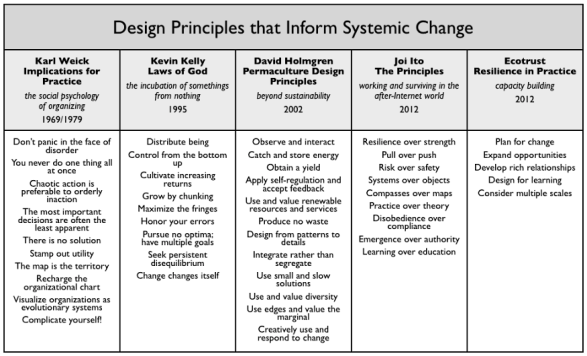
“Always love declarations of principles,” professed Bruce Sterling in his 2013 SXSW talk. “It’s not that I obey them. I’m just glad to see them.”
If, like Bruce S. (and me), you love design principles, you’re in luck. They seem to be everywhere.
One reason, I think: When dominant institutions are inadequate to contemporary challenges — when things are stuck — design principles can inform practice, focusing attention on how to move forward, albeit without assurances that such incremental movements will add up to desired outcomes.
Some well-known principles are specified by context, like agile software development or adaptive ecosystem management.
I’m thinking here, though, about ones that are framed more broadly — ones that can be read as informing understandings and practices of systemic change.
At top are four sets I’ve found intriguing and insightful, along with one from a project I led at Ecotrust. Here is a larger version of the image.
A little background on each:
- “A Swiss army knife for organizational design,” was Karl Weick’s description of his book, The Social Psychology of Organizing, which concluded with a list of “implications for practice,” here in its expanded 1979 version. (See also: Wired interview.)
- In the closing chapter of Out of Control, Kevin Kelly discerned Nine Laws of God: “organizing principles that can be found operating in systems as diverse as biological evolution and SimCity.”
- David Holmgren’s principles served as the frontispiece to his Permaculture: Principles and Pathways Beyond Sustainability. Permaculture is defined on Wikipedia as “a system of agricultural and social design principles centered around simulating or directly utilizing the patterns and features observed in natural ecosystems.”
- The Principles were characterized by MIT Media Lab Director Joi Ito as essential to working and surviving in the after-Internet world of today, and elsewhere described as “guid[ing] the Media Lab’s work under his leadership.” (See: Wired interview, INKtalks video, MIT-Knight Civic Media Conference video.)
- Seeking to better understand and describe resilience in practice, Ecotrust colleagues and I specified five areas for capacity building. See Resilience & Transformation: A Regional Approach and this post.
Clearly, these principles reflect differing vantage points: Weick is an organizational and management theorist, Kelly and Ito bring tech perspectives, Holmgren and Ecotrust environmental backgrounds. Nonetheless, I find there’s a certain complementarity among them — differing emphases, yet each informing the others.
To be sure, individual principles can be fairly cryptic, so getting a better grasp of them may require following the links, along with further reading.
I’m going to wrap here by re-linking to the worth-re-visiting 2013 talk by Bruce Sterling at SXSW, where Joi Ito’s principles were apparently on display in the Maker Tent.
This piece ~40:00:
Let me point out the difficulty with this approach — although I respect it very much, and I even understand it as a description of my own practice, something I’ve been doing for a long time. What’s the problem? The problem is that it intensifies the churn. It doesn’t cure it or stop it or help it. It’s creating part of the problem. A world in which everybody did that would be a hundred times more disturbed than it is right now.
Hmm.

